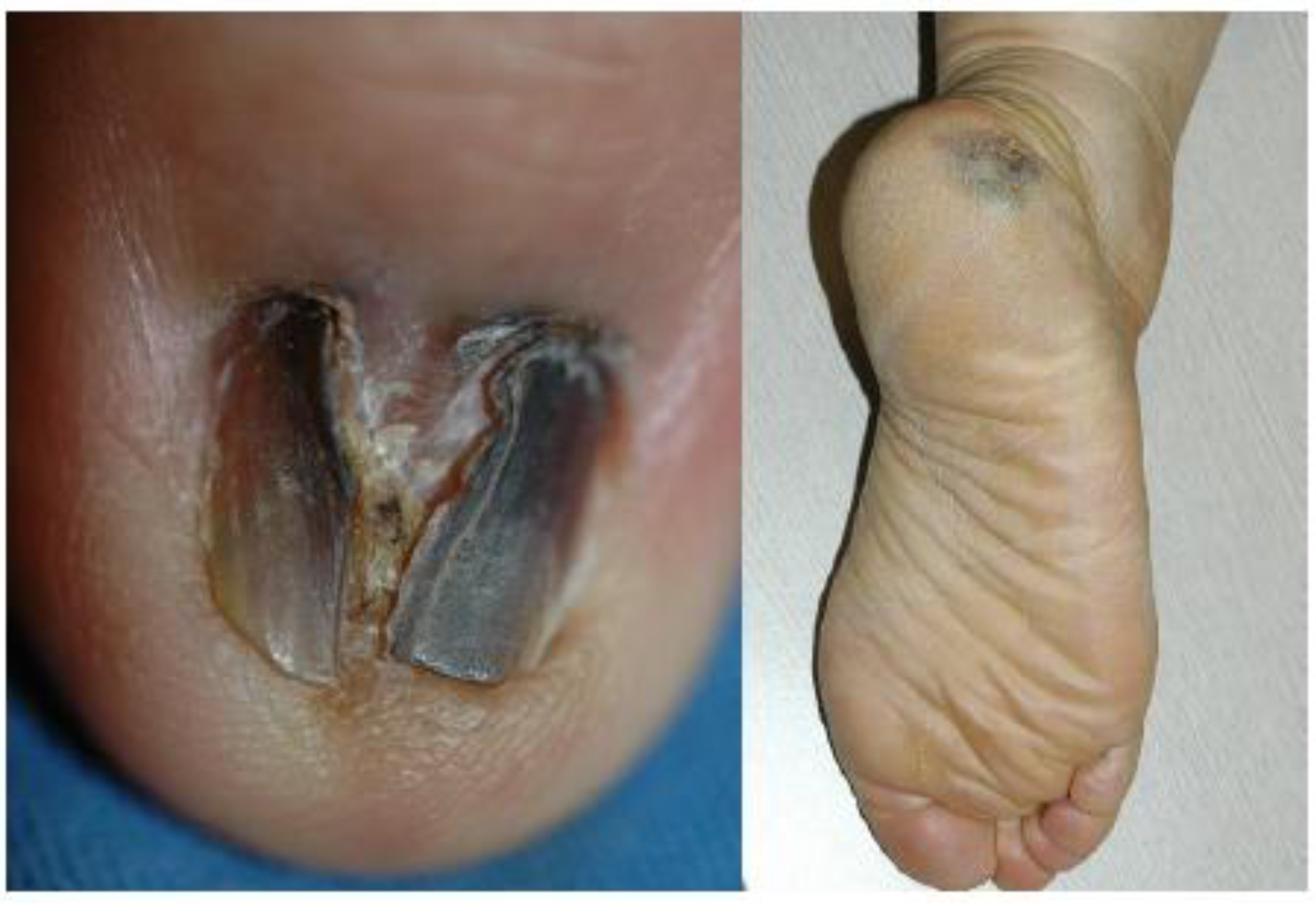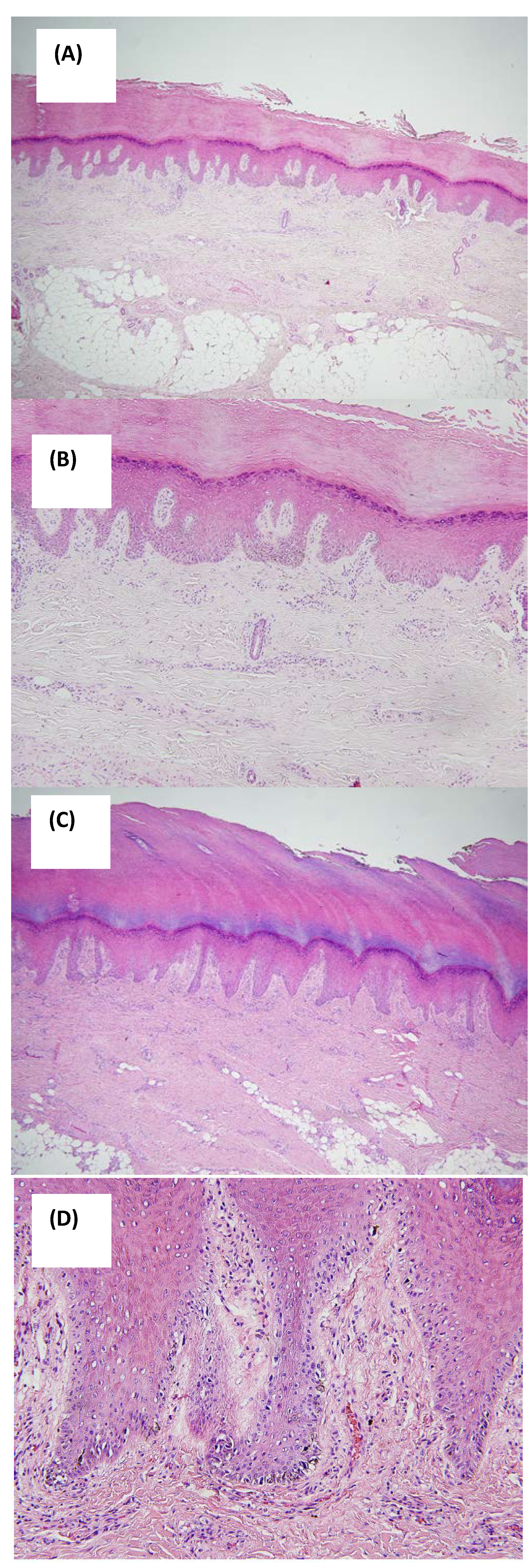Acral Lentiginous Melanoma in Situ: A Diagnostic and Management Challenge
Abstract
:1. Introduction
2. Results and Discussion
2.1. Clinical Features

| Patient number | Age/sex | Site | Duration (years) | Maximum diameter (cm) | Initial treatment | Follow up period (months) | Recurrence | Clinical status |
|---|---|---|---|---|---|---|---|---|
| 1 | 46/F | heel | unknown | 0.7 | 5 mm margin excision, clear resection margin | 39 | no recurrence | alive without evidence of disease |
| 2 | 58/F | heel | 1 | 0.6 | 3 mm margin excision, clear resection margin | 51 | after 24 months, local recurrence | alive after recurrence |
| 3 | 47/M | finger nail, 5th | 5 | excisional biopsy, involvement of resection margin | 120 | after 84 and 96 months, local recurrence and nodal metastasis | alive without evidence of disease after amputation (clear resection margin), chemotherapy and lymph node dissection | |
| 4 | 50/F | finger nail, 1st | 3 | amputation, clear resection margin | 32 | no recurrence | alive without evidence of disease | |
| 5 | 75/M | heel | 5 | 2.5 | 1cm margin excision, clear resection margin | 9 | no recurrence | alive without evidence of disease |
| 6 | 74/M | finger nail, 4th | 3 | excisional biopsy and nail extraction, no information upon resection margin | 144 | after 120 months, local recurrence | alive without evidence of disease after 5 mm margin excision (clear resection margin) | |
| 7 | 59/F | heel | 3 | 4.0 | 1cm margin excision, clear resection margin | 15 | no recurrence | alive without evidence of disease |
2.2. Histopathologic Features

2.3. Diagnosis
2.4. Treatment and Outcome
2.5. Discussion
3. Experimental
3.1. Clinical Findings
3.2. Histopathology
3.3. Immunohistochemistry
4. Conclusions
References
- Reed, R.J. New Concepts in Surgical Pathology of the Skin; Hartmann, W., Ed.; Wiley: New York, NY, USA, 1976; pp. 89–90. [Google Scholar]
- Feibleman, C.E.; Stoll, H.; Maize, J.C. Melanomas of the palm, sole, and nailbed: a clinicopathologic study. Cancer 1980, 46, 2492–2504. [Google Scholar] [CrossRef]
- Paladugu, R.R.; Winberg, C.D.; Yonemoto, R.H. Acral lentiginous melanoma.A clinicopathologic study of 36 patients. Cancer 1983, 52, 161–168. [Google Scholar] [CrossRef]
- Kwon, I.H.; Lee, J.H.; Cho, K.H. Acral lentiginous melanoma in situ: a study of nine cases. Am. J. Dermatopathol. 2004, 26, 285–289. [Google Scholar] [CrossRef]
- Stalkup, J.R.; Orengo, I.F.; Katta, R. Controversies in acral lentiginous melanoma. Dermatol. Surg. 2002, 28, 1051–1059. [Google Scholar] [CrossRef]
- Ridgeway, C.A.; Hieken, T.J.; Ronan, S.G.; Kim, D.K.; Das Gupta, T.K. Acral lentiginous melanoma. Arch. Surg. 1995, 130, 88–92. [Google Scholar] [CrossRef]
- Ishihara, K.; Saida, T.; Yamamoto, A. Updated statistical data for malignant melanoma in Japan. Int. J. Clin. Oncol. 2001, 6, 109–116. [Google Scholar] [CrossRef]
- Park, K.D.; Lee, S.J.; Lee, W.J.; Kim, D.W.; Chung, H.Y.; B.C., C. Clinicopathological features of cutaneous malignant melanoma. Korean J. Dermatol. 2007, 45, 149–158. [Google Scholar]
- Phan, A.; Dalle, S.; Touzet, S.; Ronger-Savle, S.; Balme, B.; Thomas, L. Dermoscopic features of acral lentiginous melanoma in a large series of 110 cases in a white population. Br. J. Dermatol. 2009, in press. [Google Scholar]
- Saida, T.; Yoshida, N.; Ikegawa, S.; Ishihara, K.; Nakajima, T. Clinical guidelines for the early detection of plantar malignant melanoma. J. Am. Acad. Dermatol. 1990, 23, 37–40. [Google Scholar] [CrossRef]
- Mikhail, G.R. Hutchinson's sign. J. Surg. Oncol. 1986, 12, 519–521. [Google Scholar]
- Saida, T.; Miyazaki, A.; Oguchi, S.; Ishihara, Y.; Yamazaki, Y.; Murase, S.; Yoshikawa, S.; Tsuchida, T.; Kawabata, Y.; Tamaki, K. Significance of dermoscopic patterns in detecting malignant melanoma on acral volar skin: results of a multicenter study in Japan. Arch. Dermatol. 2004, 140, 1233–1238. [Google Scholar] [CrossRef]
- Oguchi, S.; Saida, T.; Koganehira, Y.; Ohkubo, S.; Ishihara, Y.; Kawachi, S. Characteristic epiluminescent microscopic features of early malignant melanoma on glabrous skin. A videomicroscopic analysis. Arch. Dermatol. 1998, 134, 563–568. [Google Scholar] [CrossRef]
- Chiu, H.H.; Hu, S.C.; Ke, C.L.; Cheng, S.T. Dermoscopy identifies histopathologically indiscernible malignant lesion of atypical melanosis of the foot, an early lesion of acral lentiginous melanoma in situ. Dermatol. Surg. 2008, 34, 979–983. [Google Scholar] [CrossRef]
- Ishihara, Y.; Saida, T.; Miyazaki, A.; Koga, H.; Taniguchi, A.; Tsuchida, T.; Toyama, M.; Ohara, K. Early acral melanoma in situ: correlation between the parallel ridge pattern on dermoscopy and microscopic features. Am. J. Dermatopathol. 2006, 28, 21–27. [Google Scholar] [CrossRef]
- Yamaura, M.; Takata, M.; Miyazaki, A.; Saida, T. Specific dermoscopy patterns and amplifications of the cyclin D1 gene to define histopathologically unrecognizable early lesions of acral melanoma in situ. Arch. Dermatol. 2005, 141, 1413–1418. [Google Scholar] [CrossRef]
- Ronger, S.; Touzet, S.; Ligeron, C.; Balme, B.; Viallard, A.M.; Barrut, D.; Colin, C.; Thomas, L. Dermoscopic examination of nail pigmentation. Arch. Dermatol. 2002, 138, 1327–1333. [Google Scholar] [CrossRef]
- Scolyer, R.A.; Thompson, J.F.; McCarthy, S.W.; Strutton, G.M.; Elder, D.E. Incomplete biopsy of melanocytic lesions can impair the accuracy of pathological diagnosis. Australas. J. Dermatol. 2006, 47, 71–73; author reply 74–75. [Google Scholar] [CrossRef]
- Zalla, M.J.; Lim, K.K.; Dicaudo, D.J.; Gagnot, M.M. Mohs micrographic excision of melanoma using immunostains. Dermatol. Surg. 2000, 26, 771–784. [Google Scholar] [CrossRef]
- Zitelli, J.A.; Brown, C.D.; Hanusa, B.H. Surgical margins for excision of primary cutaneous melanoma. J. Am. Acad. Dermatol. 1997, 37, 422–429. [Google Scholar] [CrossRef]
- Brodland, D.G. The treatment of nail apparatus melanoma with Mohs micrographic surgery. Dermatol. Surg. 2001, 27, 269–273. [Google Scholar]
- Griego, R.D.; Zitelli, J.A. Mohs micrographic surgery using HMB-45 for a recurrent acral melanoma. Dermatol. Surg. 1998, 24, 1003–1006. [Google Scholar]
- Charles, C.A.; Yee, V.S.; Dusza, S.W.; Marghoob, A.A.; Oliveria, S.A.; Kopf, A.; Rigel, D.; Halpern, A.C. Variation in the diagnosis, treatment, and management of melanoma in situ: a survey of US dermatologists. Arch. Dermatol. 2005, 141, 723–729. [Google Scholar] [CrossRef]
- Bae, J.M.; Kim, H.O.; Park, Y.M. Progression from acral lentiginous melanoma in situ to invasive acral lentiginous melanoma. Ann. Dermatol. 2009, 21, 185–188. [Google Scholar] [CrossRef]
- Cho, K.H.; Lee, D.Y.; Kim, C.W. Erythema induratum of Bazin. Int. J. Dermatol. 1996, 35, 802–808. [Google Scholar] [CrossRef]
© 2010 by the authors; licensee MDPI, Basel, Switzerland. This article is an open access article distributed under the terms and conditions of the Creative Commons Attribution license (http://creativecommons.org/licenses/by/3.0/).
Share and Cite
Park, H.S.; Cho, K.H. Acral Lentiginous Melanoma in Situ: A Diagnostic and Management Challenge. Cancers 2010, 2, 642-652. https://doi.org/10.3390/cancers2020642
Park HS, Cho KH. Acral Lentiginous Melanoma in Situ: A Diagnostic and Management Challenge. Cancers. 2010; 2(2):642-652. https://doi.org/10.3390/cancers2020642
Chicago/Turabian StylePark, Hyun Sun, and Kwang Hyun Cho. 2010. "Acral Lentiginous Melanoma in Situ: A Diagnostic and Management Challenge" Cancers 2, no. 2: 642-652. https://doi.org/10.3390/cancers2020642
APA StylePark, H. S., & Cho, K. H. (2010). Acral Lentiginous Melanoma in Situ: A Diagnostic and Management Challenge. Cancers, 2(2), 642-652. https://doi.org/10.3390/cancers2020642




